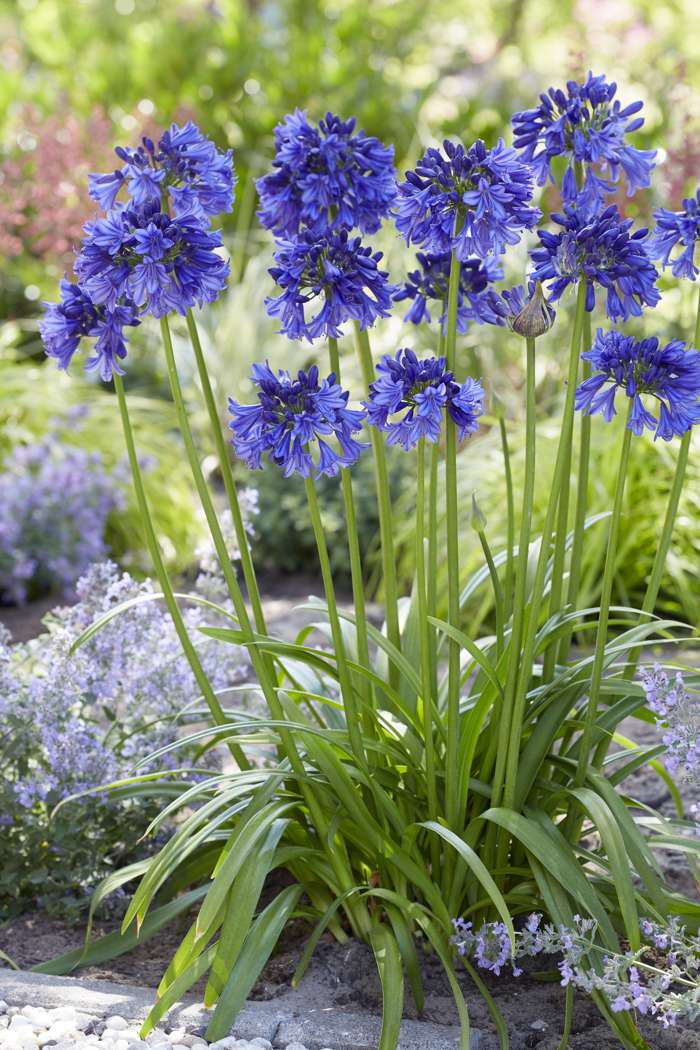Exactly how to Plant and Maintain Agapanthus in Your Garden
Exactly how to Plant and Maintain Agapanthus in Your Garden
Blog Article
Mastering the Art of Agapanthus Care: Necessary Actions for Healthy And Balanced Growth and Vibrant Blooms
In the realm of cultivation, the growing of agapanthus stands as a fulfilling venture for those that look for to support these elegant flowering plants. With their striking flowers and stylish foliage, agapanthus has actually recorded the interest of gardeners worldwide. Nevertheless, accomplishing optimal growth and vibrant blooms needs a nuanced approach that incorporates various essential actions. From picking the appropriate variety to understanding pruning techniques, the journey towards cultivating thriving agapanthus plants is multifaceted and holds the essential to opening the complete capacity of these organic treasures.

Picking the Right Agapanthus Variety

When selecting the ideal Agapanthus variety for your garden, consider aspects such as environment viability, flower color, and growth practice. Furthermore, think about the climate in your area to ensure the Agapanthus selection you select can flourish in your details problems. Comprehending the development practice of different Agapanthus selections is crucial for correct positioning within your garden.
Suitable Planting Problems
Thinking about the ideal ecological requirements is important for successful Agapanthus growing. Agapanthus prospers in well-draining dirt with a somewhat acidic to neutral pH degree. When planting, pick a location that gets complete sunshine to partial color. In hotter climates, giving some afternoon shade can avoid scorching of the fallen leaves. Agapanthus plants are delicate to chilly temperatures and ought to be secured from frost throughout cold weather.
To ensure healthy and balanced growth and lively flowers, plant Agapanthus light bulbs at a deepness of regarding 2-4 inches and room them 8-12 inches apart. Mulching around the base of the plants assists keep dampness and reduces weed growth.
Watering and Feeding Tips
Maintaining correct moisture levels and supplying vital nutrients are vital elements in the treatment regimen for Agapanthus plants. When it comes to sprinkling Agapanthus, it is important to strike an equilibrium. These plants prefer regularly moist soil however are at risk to root rot if overwatered.
Feeding Agapanthus is necessary for advertising healthy and balanced growth and prolific blooms. Apply a balanced plant food, such as a 10-10-10 formula, in the early springtime as brand-new development emerges. Repeat this application every 6-8 weeks throughout the growing season. Stay clear continue reading this of too much fertilization, as it can bring about lush foliage at the expenditure of blooms. Constantly comply with the supplier's guidelines for correct dilution and application techniques. By following these watering and feeding suggestions, you can guarantee your Agapanthus plants flourish and create dynamic, resilient flowers.
Trimming Techniques for Agapanthus
Trimming Agapanthus plants at the ideal times and with correct methods is critical for maintaining their health and advertising ideal growth and flowering. The ideal time to prune Agapanthus is in late winter season or very early spring before new growth emerges.
Deadheading invested blossoms can additionally reroute the plant's power right into producing even more blossoms instead than setting seeds. If you desire to accumulate seeds for proliferation, leave some blossoms to completely dry and mature on the plant.
Keep in mind to use clean, sharp tools to make accurate cuts and minimize the risk of presenting conditions. Agapanthus. Routine trimming will assist maintain your Agapanthus looking healthy and balanced and neat while making certain a plentiful screen of stunning blooms
Dealing With Usual Bugs and Illness
After guaranteeing proper trimming methods for Agapanthus, it is vital to deal with typical parasites and conditions that can impact the wellness and vigor like it of these plants. Agapanthus plants are usually durable but can still come down with particular problems. One typical pest that impacts Agapanthus is the Agapanthus gall midget. This tiny, orange fly lays its eggs in the vegetation, resulting in altered development and blossom buds that fall short linked here to open. To fight this parasite, prune and damage any affected plant parts and take into consideration utilizing insecticidal soap.
In addition, Agapanthus plants can experience from root rot if they are planted in inadequately draining soil. By being vigilant and taking timely activity against insects and diseases, you can help your Agapanthus plants prosper and produce lively blossoms. Agapanthus.

Final Thought
To conclude, grasping the art of agapanthus care entails selecting the appropriate range, supplying optimal growing conditions, correct watering and fertilizing, suitable trimming strategies, and resolving common bugs and diseases. By following these important steps, you can guarantee healthy and balanced growth and vivid blossoms for your agapanthus plants. Keep in mind to on a regular basis keep track of and maintain your plants to promote their overall health and durability.
To ensure healthy and balanced growth and vivid flowers, plant Agapanthus bulbs at a deepness of concerning 2-4 inches and space them 8-12 inches apart. By following these watering and fertilizing tips, you can ensure your Agapanthus plants prosper and create vibrant, durable flowers.
One usual bug that affects Agapanthus is the Agapanthus gall midget. Additionally, Agapanthus plants can endure from root rot if they are grown in inadequately draining dirt. By complying with these essential actions, you can ensure healthy and balanced growth and lively blooms for your agapanthus plants.
Report this page